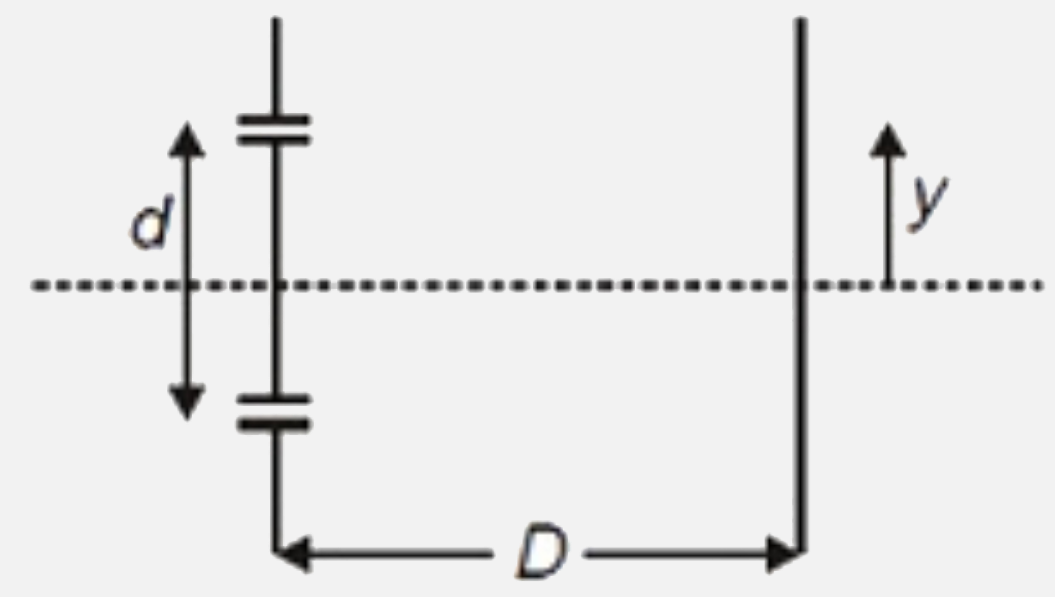In YDSE a parallel beam of incident light consists of two wavelengths λ1=4000Åandλ2=5600Å. The minimum distance y on the screen, measured from the central axis, where the bright fringe due to two wavelengths coincide is nλ1Dd. Find n.

The correct Answer is:7
Step by step video & image solution for In YDSE a parallel beam of incident light consists of two wavelengths lambda_(1)=4000Å and lambda_(2)=5600Å. The minimum distance y on the screen, measured from the central axis, where the bright fringe due to two wavelengths coincide is (nlambda_(1)D)/(d). Find n. by Physics experts to help you in doubts & scoring excellent marks in Class 12 exams.
Updated on:21/07/2023Topper's Solved these Questions
Similar Questions
A beam of light consisting of wavelengths 6000 Å and 4500 Å is used in a YDSE with D = 1 m and d = 1 mm. Find the least distance from the central maxima, where bright fringes due to the two wavelengths coincide.
View SolutionIn Young's double slit experiment, the slits are 2mm apart and are illuminated by photons of two wavelengths λ1=12000A and λ2=10000A. At what minimum distance in mm from the common central bright fringe on the screen 2m from the slit will a bright fringe from one interference pattern coincide with a bright fringe from the other?
View Solution
Knowledge Check
Bichromatic light of wavelengths λ1=5000Åandλ2=7000Å are used in YDSE. Then,
A14th order maxima of λ1 will coincide with 10th order maxima of λ2B21st order maxima of λ2 will coincide with 15th order maxima of lambda_1C11th order minima of λ1willco∈cwith8thorderminimaoflambda_2D3rd order minima of λ1 will coincide with 4th order minima of λ2The ratio of resolving power of an optical microscope for two wavelength λ1=4000Å and λ2=6000Å is:
A9:4B3:2C16:81D8:27The ratio of resolving power of an optical microscope for two wavelength λ1=4000Å and λ2=6000Å is:
A9:4B3:2C16:81D8:27
In a Young's double-slit experiment, if the incident light consists of two wavelengths λ1 and λ2, the slit separation is d, and the distance between the slit and the screen is D, the maxima due to each wavelength will coincide at a distance from the central maxima, given by
View SolutionIn Young's double-slit experiment, the slits are 2mm apart and are illuminated by photons of two wavelengths λ1=12000Å and λ2=10000Å. At what minimum distance from the common central bright fringe on the screen 2m from the slit will a bright fringe from one interference pattern coincide with a bright fringe from the other?
View SolutionIn Young's double-slit experiment, the slits are 2mm apart and are illuminated by photons of two wavelengths λ1=12000Å and λ2=10000Å. At what minimum distance from the common central bright fringe on the screen 2m from the slit will a bright fringe from one interference pattern coincide with a bright fringe from the other?
View SolutionIn a Young's double slit experiment, if the incident light consists of two wavelengths λ1andλ2, the slit separation is d, and the distance between the slit and the screen is D, the maxima due to the two wavelengths will coincide at a distance from the central maxima, given by :
View SolutionIn a Young's double slit experiment, the slits are 2mm apart and are illuminated with a mixture of two wavelength λ0=750nm and λ=900nm. The minimum distance from the common central bright fringe on a screen 2m from the slits where a bright fringe from one interference pattern coincides with a bright fringe from the other is
View Solution
